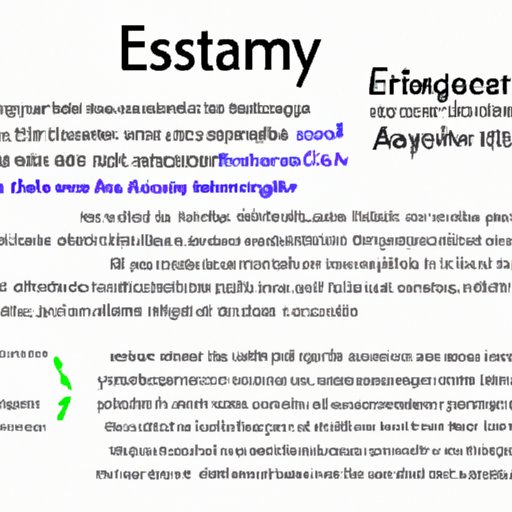Introduction
A descriptive essay is a type of writing in which you describe a thing, event, process or person. The main goal of this type of essay is to create a vivid experience for the reader and give them a more in-depth understanding of the essay’s subject. Ultimately, whatever you can perceive or experience can be the focus of your descriptive writing.
Provide an Outline of the Essay in Advance
Before you begin writing your essay, it is important to create an outline. This will help you organize your ideas and determine the order in which you want to present them. Here are some steps to follow when creating an outline:
Brainstorming Ideas
Take some time to think about the topic you have chosen. What details do you want to include in your essay? What emotions does the topic evoke? What specific features stand out? Write down all the ideas that come to mind as you brainstorm.
Develop a Focused Thesis Statement
Your thesis statement should be concise and reflect the type of paper you are writing. All of your body paragraphs and information will revolve around your thesis, so make sure that you are clear on what your thesis is. For example, if you are writing a descriptive essay about your camping trip, you might have a thesis like: “My camping trip was a life-changing experience that helped me appreciate the wonders of nature.”
Create an Outline
Once you have your thesis, you can start creating an outline for your essay. Start by listing the main points that you want to discuss in your paper. Then, fill in supporting evidence beneath each point. This may include facts, quotes, and examples. Finally, decide on the order in which you want to present your points.

Focus on Specific Details and Descriptive Words
In a descriptive essay, you should use interesting details and descriptive words to paint a vivid picture for the reader. Here are some tips for doing that:
Use Vivid Imagery to Describe Scene
When describing a scene or setting, try to use words that will bring it to life for the reader. Think about the sights, smells, and sounds that you experienced in that location. According to a study published in the Journal of Memory and Language, concrete images can help readers recall information more easily than abstract words.
Choose Words that Evoke Emotion
You want your reader to feel something when they read your essay. Choose words that evoke emotion to create a powerful connection between your reader and the topic. For example, instead of saying “I was scared”, you could say “my heart raced with fear”.

Start with a Strong Introduction
The introduction is the first part of your essay that the reader will encounter, so it’s important to make a good first impression. Here are some tips for writing a strong introduction:
Hook the Reader
Start your introduction with a sentence that grabs the reader’s attention. You can use an anecdote, an interesting fact, or a quote to draw the reader in. This will help set the stage for the rest of your essay.
Introduce the Topic
Once you have hooked the reader, you should provide some context for your essay. Explain what the topic is and why it is important. This will help the reader understand the main points of your essay and how they are related.
Set the Tone
The tone of your essay should match the mood of the topic. Is it a serious topic or a lighthearted one? Use language that reflects the tone you want to set for your essay.
Show, Don’t Tell, the Story of Your Essay
When writing a descriptive essay, you should show, not tell, the story of your essay. Here are some tips for doing that:
Use Action Verbs
Action verbs can help you describe the scene and characters more effectively. Instead of saying “he walked”, you could say “he sauntered”. This will give the reader a better sense of the scene and make it more engaging.
Use Sensory Language
Sensory language can help the reader experience the scene through their five senses. Describe what the character is seeing, hearing, smelling, tasting, and feeling. This will make the scene more vivid and immersive for the reader.
Conclusion
Writing a descriptive essay can be challenging, but with these helpful tips, you can create an engaging and memorable piece of writing. Start by brainstorming ideas, developing a focused thesis statement, and creating an outline. Focus on providing specific details and descriptive words, and start your essay with a strong introduction. Show, don’t tell, the story of your essay by using action verbs and sensory language. With practice and patience, you can write a descriptive essay that will engage and delight your reader.
References
Kliegl, R., & Smith, J. (2006). Increasing Text Coherence with Concrete Language. Journal of Memory and Language, 54(4), 516–535. https://doi.org/10.1016/j.jml.2005.12.
(Note: Is this article not meeting your expectations? Do you have knowledge or insights to share? Unlock new opportunities and expand your reach by joining our authors team. Click Registration to join us and share your expertise with our readers.)
